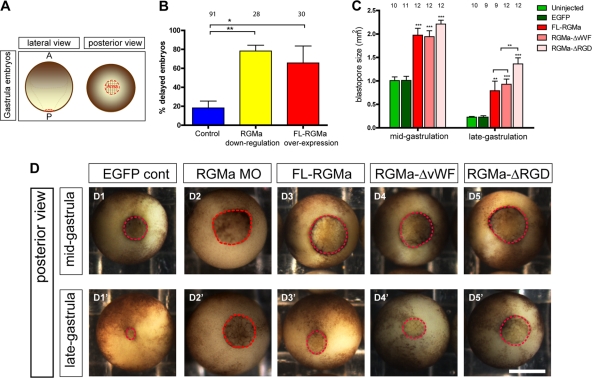Fig 7.
Embryos overexpressing RGMa mutants exhibit delays in blastopore closure during gastrula. (A) Schematic of Xenopus gastrula embryos, showing lateral and posterior views. Red dotted lines demarcate the blastopore. (B) Regulated expression of RGMa is crucial for blastopore closure during gastrulation. Embryos were injected with either RGMa-ATG morpholino (23 ng of MO) or FL-RGMa (0.6 or 1.15 ng mRNA). Control embryos were either uninjected or injected with EGFP or standard control morpholino. At late-gastrulation stage, embryos were scored for delayed blastopore closure if the blastopore area was larger than the average area of that for control animals at midgastrula (>2-h delay). Error bars indicate the standard errors of the means of the average percentages from multiple repeats (control, 7 repeats; RGMa downregulation, 3 repeats; RGMa overexpression, 3 repeats). **, P < 0.01; *, P < 0.05. (C) Blastopore size in embryos overexpressing FL-RGMa (1.15 ng each RGMa mRNA/EGFP mRNA per embryo) and RGMa mutants (1.15 ng each RGMa-ΔvWF or RGMa-ΔRGD mRNA/EGFP mRNA per embryo). Embryos overexpressing FL-RGMa and RGMa mutants were collected when 90% of control embryos passed midgastrulation stage (stage 11) and again when all control embryos passed late-gastrulation stage (stage 12). In the absence of the RGD domain, RGMa-overexpressing embryos showed a significantly large blastopore by late-gastrulation stage. ***, P < 0.001; **, P < 0.01. (D) Posterior view of a representative control embryo, an RGMa knockdown embryo, and embryos overexpressing FL-RGMa or RGMa mutants at midgastrulation (D1 to D5) and late-gastrulation (D1′ to D5′) stages. The dotted circle outlines the blastopore for each embryo. Bar, 300 μm.

